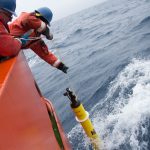University of Washington awarded $23.5M to build floating robots as part of NSF project to monitor the world’s oceans
The University of Washington is among leading U.S. oceanographic institutions that have received National Science Foundation funding to build and deploy 500 robotic ocean-monitoring floats to monitor the chemistry and biology of the world’s oceans.
The National Science Foundation on October 29 approved a $53 million, five-year grant to the Monterey Bay Aquarium Research Institute (MBARI); the UW; Scripps Institution of Oceanography; the Woods Hole Oceanographic Institution; and Princeton University. The consortium will build robotic ocean-monitoring floats to be distributed in oceans around the globe.
“This will be one of the largest awards that NSF has ever given in ocean sciences,” said Stephen Riser, a UW professor of oceanography. “It will allow us to create and deploy an ocean observing system that will operate for decades and will influence our ideas about the carbon cycle, in the same way that the basic Argo program has helped our understanding of the physics of ocean circulation.”
About $20.5 million of the award will go to the UW to build and deploy about 300 of the 500 floats, with another $3 million for maintenance. The UW team plans to begin construction in 2021 and hopes to put the first instruments in the water later that year. The new instruments are similar to roughly 200 the UW team previously built to survey the Southern Ocean around Antarctica, though these won’t have under-ice capabilities.
This new network of floats, called the Global Ocean Biogeochemistry Array, or GO-BGC Array, will collect observations of ocean chemistry and biology from the surface to a depth of 2 kilometers, or 1.24 miles. When the floats rise every nine days to the surface they will transmit data that will be made freely available to the public within a day of being collected for use by researchers, educators and policymakers around the world.
“These observations will provide an unprecedented global view of ocean processes that determine carbon cycling, ocean acidification, deoxygenation and biological productivity — all of which have a critical impact on marine ecosystems and the climate of our planet,” said Alison Gray, a UW assistant professor of oceanography.
These data will allow scientists to pursue fundamental questions about ocean ecosystems, observe ecosystem health and productivity, and monitor the elemental cycles of carbon, oxygen, and nitrogen in the ocean through all seasons of the year. Such essential data are needed to improve computer models of ocean fisheries and climate, and to monitor and forecast the effects of ocean warming and ocean acidification on sea life.
Although scientists can use Earth-orbiting platforms and research vessels to monitor the ocean, satellites can only monitor near-surface waters, and the small global fleet of open-ocean research ships can only remain at sea for so long. As a result, ocean-health observations only cover a tiny fraction of the ocean at any given time, leaving huge ocean regions unvisited for decades, or longer.
A single robotic float costs the same as two days at sea on a research ship. But floats can collect data autonomously for over five years, in all seasons — including during winter storms, when shipboard work is limited.
Since 2014 the Southern Ocean Carbon and Climate Observations and Modeling (SOCCOM) program has deployed an array of robotic “biogeochemical” floats, based on the Argo design, but carrying sensors to monitor the chemical and biological properties of the ocean. SOCCOM floats have operated for nearly six years in the remote, stormy, and often ice-covered Southern Ocean—arguably one of the harshest marine environments on Earth. These floats have already provided critical new information about how the Southern Ocean interacts with the Earth’s atmosphere and winter sea ice.
Similar to the SOCCOM floats, the new GO-BGC floats will carry several sensors in addition to the core Argo sensors for temperature, depth and salinity. These include instruments to measure oxygen concentration, pH (ocean acidity), nitrate (an essential nutrient for microscopic algae), sunlight (required for algal growth), chlorophyll (an indicator of algal populations) and particles in the water (including microscopic algae). Over the last few years, researchers have been testing, refining and calibrating these sensitive instruments as part of the SOCCOM program and other international efforts.
MBARI will coordinate the project, refine the sensors, take the lead in processing data from the floats, and do outreach for the program. Oceanographers at the UW, Scripps and the Woods Hole will build and deploy floats in collaboration with commercial partners. Researchers at Princeton University will contribute to the array design and project management, and ensure that the data are linked to global computer models of the Earth’s ocean and climate.
A broad public outreach program, including workshops, web-based curricula and hands-on activities will help scientists, teachers, students and others use the data. In an expansion of the existing SOCCOM Adopt-A-Float program, the floats will be adopted by elementary- to college-level classes. Student activities will be developed through a partnership with the national Marine Advanced Technology Education program. Courses based on GO-BGC technology will also be offered through the The Sandbox, a makerspace at the Scripps Institution of Oceanography.
The researchers hope that GO-BGC will inspire other countries to contribute similarly instrumented floats, as part of the new global biogeochemical Argo effort. Ideally, this expanded network will grow to a sustained array of 1,000 biogeochemical floats uniformly distributed around the world’s oceans, and spaced about 620 miles, or 1,000 kilometers, apart from each other.
“Until now, biogeochemical data has not been collected for the vast majority of the world’s ocean. GO-BGC will transform our ability to observe and understand the chemical and biological cycles that are the foundation of marine food webs,” said principal investigator Ken Johnson, a marine chemist at MBARI.

